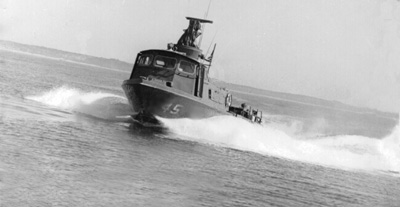
| A Tour of the Boat |
|
| Closeup View of a Mark I Swift Boat |
 |
Come along as we take a "virtual" tour through PCF 45. The boat was not very large, so the trip will be an abbreviated one. However, we will take the opportunity along the way to point out as many of the boat's unique features as time allows during this short visit to the various areas of the craft that was our home away from base during the year that we spent in Vietnam. |
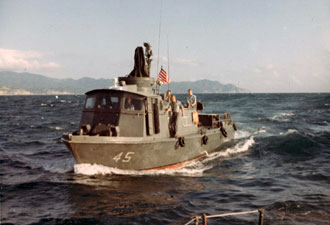 |
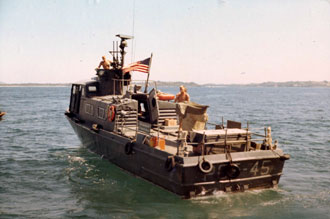 |
The tour starts, naturally enough, topside in the dual .50 caliber machine gun tub.This was located over the rear of the pilot house, and was accessed by either climbing the short ladder on the starboard side onto the main cabin overhead and then into the tub, or by a vertical access hatch inside the boat at the back of the pilot house. |
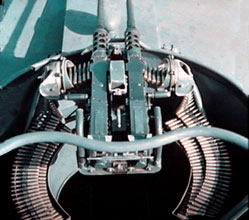 |
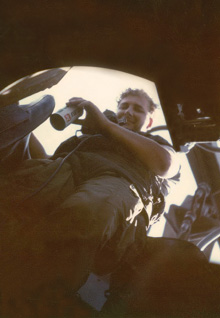 |  |
The location of the guntub provided not only a clear field of fire for one of the main weapons of the boat, but also, because of its height, was manned as a lookout station whenever the boat was underway. The crewman on lookout was able take immediate action against any hostile actions encountered on patrol with a weapon that produced a heavy punch. The gun tub was also a great place to grab a spare life jacket to sit on, take in a few photons, and observe the world from a prime vantage point while anchored or tied alongside the dock. |
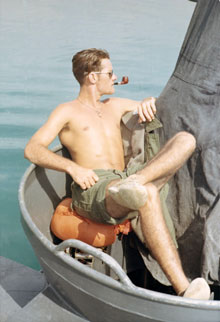 |
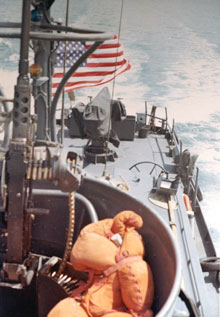 |
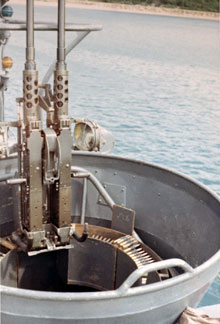 |
The dual 50's were mounted on a swivel ring that allowed the gunner to traverse the aiming of the guns in both azimuth and elevation. They were fed from ammunition belts stowed in trays on either side of the guns, which also rotated with the ring as the guns were traversed. Normal loading was with one tracer round in five to aid the gunner in laying his fire on the target. |
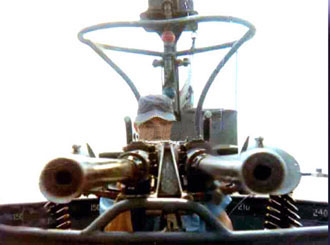 |
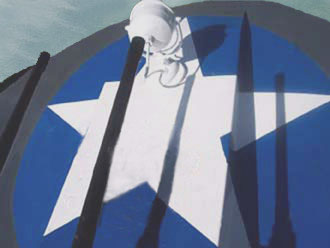 |
Immediately aft of the gun tub was a short mast supporting the navigation lights and the antenna for the commercial radar. Forward on the pilot house overhead was the search light in the middle of a painted blue circle with white star overlay. |
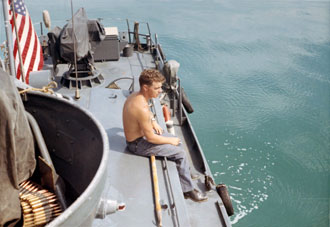 |
Topside aft of the mast was the overhead for the main cabin. Since the cabin deck was recessed lower into the hull, the overhead was only about waist high off the main deck. This formed a natural table on which to place needed items such as a boat hook and mooring lines. It also made a convenient bench to rest on and get away from the radio noise of the boat's interior. You can also see the antenna for the upgraded VHF FM radio mounted on the raised flange over the after hatch leading to main cabin. The HF antenna was mounted closer to the mast. |
At the far end of the cabin area, on the port side, was the after steering station. This had a clutch engaged replica of the helm in the pilot house, and a second set of dual throttle controls for the two engines. This was the primary conning position for going alongside vessels to be searched, or when maneuvering during docking. Bob Stephenson, our B'osn, was an expert boat handler, and carried out these functions with the skill and grace of a true professional ... under the watchful guidance of the rest of the crew, of course |

|
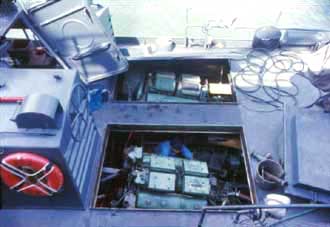 Image courtesy of Roger LeMaster |
The two V-12 diesel engines were located under covers immediately aft of the main cabin after hatchway. With the covers off, easy access was provided to the engineering space that included, in addition to the engines, the main shaft couplings and transmissions, Onan 6 KW 120 VAC generator, and the primary electrical system of twin banks of large 24 volt batteries with associated alternators. The eight hundred gallon plus diesel fuel tanks were aft of the engine room and were filled through capped tubes located on either side of the naval gun. |
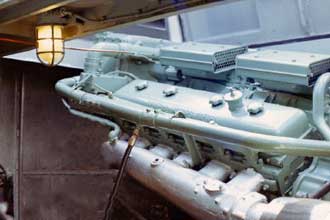 |
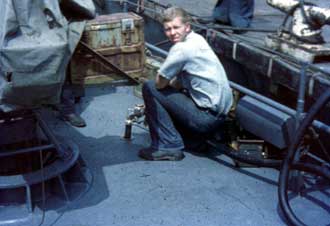 |
The main armament carried by Swift Boats and Coast Guard WPB's was the unique over-and-under weapon arrangement of a .50 caliber machine gun and naval mortar. The weapon was affixed on top of a two way swivel tripod mount located on the fantail The quadrant on the left side of the gun enabled the elevation to be set at a predetermined angle when the weapon was utilized for indirect high explosive fire or illumination support. The device on each side of the service locker was used to set the timed fuse on the illumination rounds. | 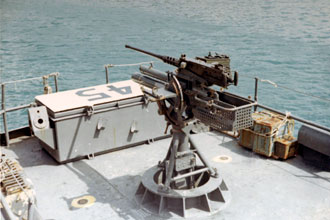 |
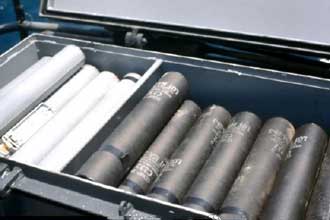 Image courtesy of Herb Blume |
The naval gun/mortar was usually trigger fired, but utilized standard 81mm mortar rounds, loaded from the front of the weapon. These rounds were kept in the ready service locker located at the extreme end of the fantail, seen with the white top and the black number 45 stenciled on it. The complement of 81mm rounds carried on patrol was 80 rounds of HE (high explosive), 15 WP (white phosphorus), and 20 of the timed fuse illumination rounds. The bulk of this load was stored under the floor in the main cabin and transferred to the service locker when needed. |
Ammunition for the .50 caliber machine gun was held in the box on the right side. In the original design of the boat, this box held
100 rounds of ammuntion, belted as one tracer round for every four ball rounds. As a later modification, this box was enlarged
to hold up to 1600 rounds.
The basket looking structure at the rear of the naval gun/mortar provided recoil protection, as a counter balance and also
assistance in steadying the machine gun with the gunner's body
|
 Image courtesy of Dave Pendergrass |
The procedures, and cautions, used to operate this weapon are covered in the web site section Misfire and will not be repeated here. Suffice it to say that the gun gave the Swifts and WPB's formidable fire power. Although limited to a range of a few thousand yards, it had almost the equivalent explosive power of the three inch guns carried on the larger Destroyer Escorts, Mine Sweepers and Patrol Gunboats. |
For more information on the design and development of this unique weapon, see Bob Stoner's' Mk 2 Mod 0 and Mod 1 .50 Caliber MG/81mm Mortar Description |
Note the difference in the framing between the front wind screens and the side window. During our initial patrols, the front wind screens also used the rubber gasket framing. These allowed the wind screens to be "blown out" when a "greenie" wave was taken over the bow during rough seas. This happened twice to PCF 45. Not a pleasant experience. The sturdy metal frames installed as an upgrade to the front wind screens solved this problem. |
| In front of the seat and the helm was a panel containing the engine instrumentation and below it, various electrical switches to control engine start/stop and navigation/external lighting. |
Starting from the top of the panel, below the compass, was a dial indicating the position of the rudder. Low level panel illumination came from the covers on each side of the rudder indicator. The remaining dials and gages were arranged left and right symmetrically for the port and starboard engines. Outboard below the rudder indicator were tachometer dials for individual RPM (Revolutions Per Minute) speed of each engine, with their water temperature gages just inboard. Arranged along the bottom row of the panel were, from outboard to center, the current meters for the alternator-chargers connected to the engines, the oil pressure gages for each transmission and engine oil pressure gages underneath each temperature gage. |
 |
| Image courtesy of Herb Blume |
| The light in the center of the panel below the temperature gages was the engine warning light. |
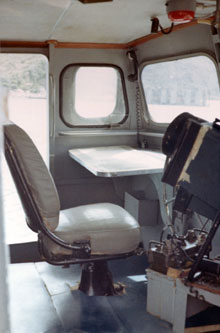 |
The commercial radar was invaluable for navigation and surface searches during nightime. It was also the primary "gun laying
director" for indirect fire and illumination support. The display console, to the helmsman's right, provided only a relative bearing
presentation with fixed range rings and a plastic overlay cursor to locate targets. The hood over the display face was used
during the day to cut down on glare, and was removed during darkness.
The table on the port side was a convenient place for not only patrol charts but also other documents needed on patrol. The
padding on the pilot house deck was not a luxury item.
When our crew arrived in country, the only radio installed on the boats was HF. This quickly proved incompatible with
the need for short range tactical communications with other boats and the land based military units we regularly operated
with.
|
Older analog tuned versions of the US Army AN/PRC-10 VHF FM "backpack" radio were "scrounged" and lashed to the starboard side of the dashboard, with the whip antenna sticking out the starboard hatch. These were soon replaced with more modern "synthesized" tuned AN/PRC-25 portable units, and a bracket was fabricated to hold what became our primary / only means of communication. This radio and its bracket can be seen located in front of and under the radar display. |
Immediately aft of the pilot house was the main cabin area. Looking forward from the center of the cabin, on the port side, was the companionway leading up to the pilot house. To its right, the bulkhead formed by the vertical hatch from pilot house to the gun tub was used as a bulletin board. Below it was the open access to the forward berthing area underneath the pilot house. Because the bulkheads of this space were formed by the bow structure, it was fairly constricted. But it did contain two "racks" configured in a vee shape. There was also a hatch from the forward berthing area up to the foc'sal. |  |
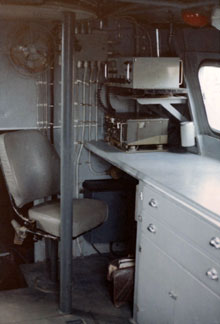 |
A long built-in counter top extended along the starboard side of the cabin. At the forward end of this table were
installed the HF and the later upgrade VHF FM radio. The drawers for the charts and stowage space for personal weapons
and other items were located underneath the counter top.
The grey colored AN/URC-58 HF radio was on the upper shelf. Due to equipment limitations of the shore based stations
at the time, this radio was almost never used during our tour. The Collins S-line amateur radio based radios, and
associated poor antennas, that the surveillance control centers were initially equipped with proved inadequate. Therefore
the HF radio
On the other hand, the olive drab AN/VRC-46 VHF FM radio upgrade was a major leap forward in our capability. This
radio was continuously monitored on the primary guard frequency for all Market Time units in a particular patrol area. |
However, the "jury rigged" AN/PRC-25 radio in the pilot house continued to be vital for inter-boat and local land unit
communications. "Jack Benny" was a common phrase heard on the guard frequency. This reference to the comedian's reputed
age was a signal to tune the portable radio to 39.00 MHZ to establish local contact.
John Willet, our radioman, was responsible for keeping all the frequency plans needed on patrol up to date. In a panic,
his skills and knowledge in knowing where and how to use the "shackle codes" for the one encrypted message we received
during our tour {from the USS Pledge MSO 492} was a lifesaver. The decrypted message read: "STEAKS ON THE GRILL" ... A tragedy if we
had missed that one !!
|
 |
 |
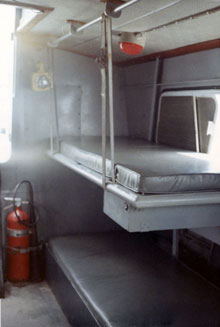 |
Turning around and looking aft from the center of the cabin area, the counter top extended down the starboard side to
the galley area. The refrigerator and freezer were located underneath. The small door at the very end of the lower counter
top allowed access to the compressors for the two food storage units next to them. On the formica top was a "dutch oven"
for cooking and the sink. A cabinet for eating utensils and a water jug completed the galley. With limited water on board,
chemical fire extenguishers were vital.
Chow on Swift Boats was actually pretty good ... as long as you had someone who knew how to prepare it. We received
raw rations before each patrol, the ones at Cam Ranh being superior to other places due to the close proximity of
the port facilities. Excellent meats, vegetables, bread, & fruits were not uncommon. We even received a "synthetic"
milk product that tasted surprisingly like the real thing. Much better than the "bug juice" that was a standard Navy
drink on deployed ships at the time. And, of course, soda pop was a necessary staple for all Swift Boat sailors.
Bob Stephenson was one of our better "chefs", and the breakfast of bacon, concentrated scrambled eggs, and bread he is
seen preparing on the electric skillet was always delicious. Great aroma !
On the port side in the after part of the cabin were two additional bunk style racks to augment the forward berthing
area. Not very elegant, but certainly preferable to the forward space during heavy seas, which was further from the
center of gravity and closer to the waves crashing into the bow.
|
Oh yeah .... since it is a question asked even of the astronauts: there was a head in the forward berthing area. But the severe consequences to our shipmates of using this facility in the less than well ventilated close quarters of this space was almost too horrible to contemplate. We managed to re-arrange our internal metabolism to delay such activities until the 24 to 36 hour patrol was over with. And a special bucket was reserved for true "emergencies." | 
|
Hope you found this tour interesting. We tried to make our "home" as livable as possible and still retain the fighting edge that was our reason for being there in the first place. We were proud of the boat and the job it was able to perform. And She'll stay afloat Thru the toughest gale And keep smiling Gordon Lightfoot� |
|
View a short video of Swift Boats UNDERWAY on along the coast and in the rivers |
| If you would like to know more about the technical details of a Swift Boat, the second part of this section contains the Patrol Craft Fast Specifications as the boats were configured in 1967. |
As a result of a visit to this section of the web site, Stu Levee in the United Kingdom decided to undertake construction of a working radio controlled model of a Swift Boat for entry in a model regatta during the late spring of 2003. He contacted me via email and telephone and we embarked on a very interesting dialog on not only the methods for constructing the model, but adding many of the historical details from an actual boat. After much discussion, Stu decided that the PCF-79 would make an appropriate example for the model due to its historic part in the Sa Ky Victory I provided hard copies of the images and text describing the Sa Ky battle for Stu to use as documentation for his scale entry in the regatta. And Ed Bergin provided images of the 79 boat in the "battle dress" as it was in July 1967 when the Sa Ky battle took place. Such details as the paint color scheme, the Coastal Division 16 patch on the port pilot house door, and the "Yabuta Eyes" that the 79 crew painted on either side of the bow to "guide" the boat thru difficult times certainly added "character" to Stu's model. |
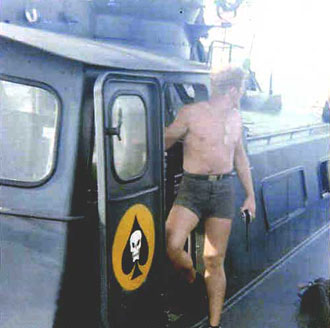 |
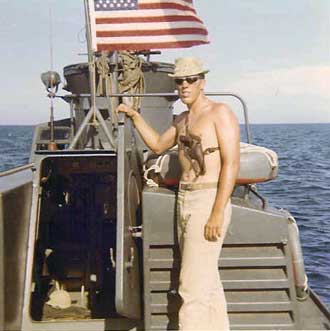 |
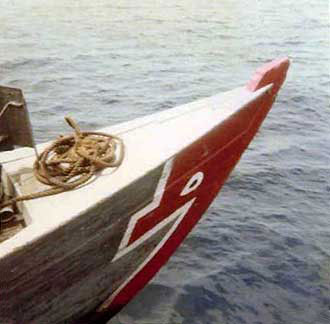 |
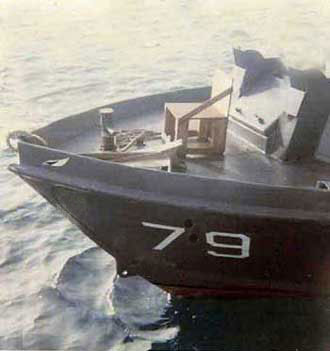 |
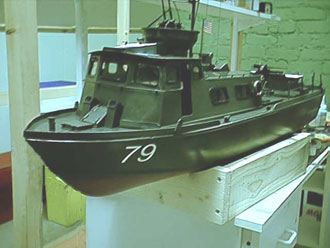 |
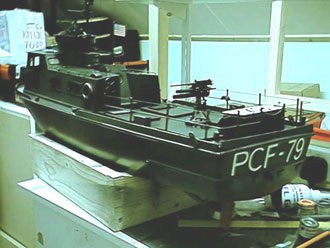 |
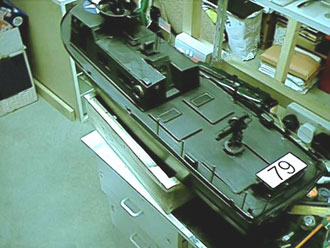 |
Not to be outdone, in the fall of 2007 Frank Donaghue forwarded to me information about his model of PCF-45 that he scratch built based upon information also gleaned from this web site. His radio controlled model Swift Boat is of comparable size to Stu's and exhibits the same excellent craftsmanship common to both models. As the following images clearly indicate, Frank is also able to bring both a gleam and a bit of mist to an old Swift sailor's eye as he puts Sand Pebble #45 through her paces on a local pond near his Northern Ireland home. Thanks for the outstanding effort Frank in bringing back some memories of those times long ago and far away |
 |
 |
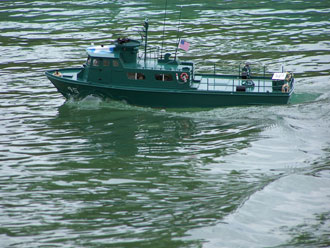 |
 |
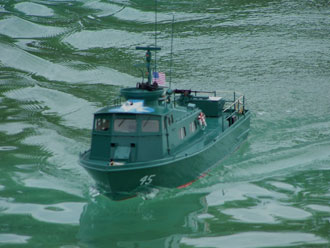 |
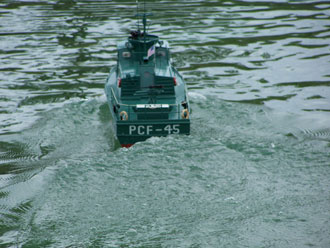 |
This web site is Copyright � 2002 by Robert B. Shirley. All rights reserved. Click on image to return to the homepage
|